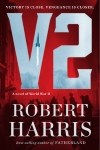Robert Harris’s most recent fictional novel V2 pictures the missile strikes during the Second World War from the firing of the Germans to the British counteraction. A lively history lesson follows two crucial characters through war.
By Katharina Schröder
Best-selling English novelist Robert Harris takes us back in time to the end of 1944, during the Dutch famine. V2 – A Novel of World War II is his newest historical fiction about the German ballistic missile launched from the Dutch coast, aiming to destroy London during World War II. The V2 strikes destroyed several areas of London, but they did not reverse the imminent defeat of Nazi Germany. Harris composed the story during the Covid lockdown, as the idea emerged when he read an obituary of a WAAF (Women’s Auxiliary Air Force) officer. His background research was thorough, and he provides a detailed list of literature about the topic. The combination of factual accuracy and fictional storytelling is well-made, allowing the reader to learn about regional history and warfare. However, the novel’s focus is on the fictional aspect.
The story is gripping and recreates the oppressive and shocking atmosphere of perpetual danger. The author describes the aftermath of a V2 strike, leaving a grotesque scene: »There was a lot of blood – on faces, on clothes, in little patches on the pavement«. The technical descriptions of the structure and function of the rockets are quite detailed, as the mechanics of the explosive missile are explained during several launches. Even though this is quite technical, the reader gets an idea of how the functional process works. Still, Harris’s writing style is pleasant to read, and the storyline is easy to follow.
Two Protagonists, Two Settings
The novel shows the launch of the missiles from Scheveningen in the Netherlands by the Germans and the British counter-operation on British and Belgian territory. The protagonist, Rudi Graf, is a German engineer and technical liaison officer who contributed to the creation of the V2. Even though he is a specialist in ballistic missiles and a crucial figure for the firing of the rockets, he is not safe from the SS henchmen and constantly under suspicion of treason. He does not share the Nazis’ ideology but becomes their expert on rockets anyway. The reader follows his career from his early ambitions of building rockets to explore space, to engineering the ballistic missile as the German »vengeance weapon«, even though he »wanted to build a spacecraft, not an instrument of murder«.

Robert Harris
V2
Penguin Random House: New York 2020
320 Seiten, $28.95 (Hardcover)
A long way off in Britain, the 24-year-old Kay Caton-Walsh is an officer of the WAAF. She has just survived a V2 strike in the centre of London; having personally experienced the impact of one of the rockets, she is determined to contribute more significantly to the counteraction against the German raid than she can do in her current occupation as a photographic reconnaissance interpreter at the Royal Air Force Station just outside London. She manages to get transferred to Belgium where she has the task of calculating the flight paths to uncover hidden German launch sites. As Belgium has just recently been liberated, the WAAF needs to keep their work secret since they are exposed to the danger of German sympathisers and possible betrayal.
The V2 was a monster.
The V2 was developed in Peenemünde, on a German island in the Baltic Sea, between 1939 and 1942. Rocket engineer Wernher von Braun was one of the main executives of the missile programme and has a minor, but still significant, role in Harris’s novel. The development of the V2 laid the foundation of aerospace technology and was the first rocket ever to reach space. However, the Germans used this technological progress for their own purpose, and it was deployed at war in 1944. Approximately 3,200 rockets were fired. About 20,000 slave labourers died building them, and the missile strikes killed about 1,700 civilians in Antwerp, Belgium, and 2,700 in London. The hits of the V2 were unpredictable and without any audible or visible warning. Initially, the British government denied the rocket attacks and blamed gas pipes for the explosions, but this declaration could not long stand its ground and the missiles were referred to as »flying gas pipes«. As the missiles were unreliable due to various issues, many exploded before taking off or during the flight or they missed the target.
The Dutch Famine
Info
We were able to review this book thanks to a cooperation with the Fachinformationsdienst Anglo-American Culture. It is now available for loan through the SUB.
The story is set in late November 1944 in London, Mechelen (Belgium), and Scheveningen (the Netherlands). Especially the chapters set in Belgium and the Netherlands depict the effects of war shortage and the Dutch Famine, also known as the Dutch Hunger Winter. As a result of the German blockade, which cut off supply, food became scarce, people began to starve, and an estimated 20,000 people died of the famine. This condition of starvation is a recurrent topic in the novel, as the Germans launched the V2’s from the affected areas, shedding light onto this lesser-known historical crisis.
V2 is one among many novels set against the backdrop of the Second World War. It is worth reading as the plot is thrilling, even though it is already known how the war ended. The alternating point of view grants insight into the viewpoints of both protagonists, Kay and Graf. It is enthralling to see how these two believable characters get along and how their story will end. Still, the novel does not sugarcoat: The atmosphere is horrifying, especially as the author gives the victims of the strikes in London names and faces. Overall, Harris created a great combination of historical circumstance and fiction.






